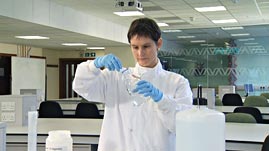Teachers' Domain - Digital Media for the Classroom and Professional Development
User: Preview




Tiny differences in DNA sequences can have profound effects on who we become and how our lives and health progress. Techniques like gel electrophoresis make it possible to visualize these variations. As this video adapted from the University of Leicester emphasizes, carefully following established procedures when creating the gel and setting up the electrophoresis apparatus is necessary to achieve accurate results.
We hear a lot about forensic DNA analysis and genetic engineering. These procedures require the ability to isolate DNA fragments of interest from the rest of an organism’s genome. However, if you've ever extracted DNA from plant or animal cells, or seen the sticky clump that often results from this process, you know that the final product isn't much to look at. So, how can a scientist or lab technician isolate a DNA fragment of interest?
Scientists use gel electrophoresis to separate nucleic acids according to their size. A key component of this process is the gel itself—which is usually made of agarose, a complex carbohydrate found in the cell walls of certain types of algae and seaweed.
For use in gel electrophoresis, purified, powdered agarose must first be fully dissolved in a heated buffer solution. This agarose solution is allowed to cool a bit and then poured into a gel tray whose ends have been sealed with tape or with removable dams that are provided with some electrophoresis equipment. Here, the gel will solidify and take the shape of the gel tray as it cools to room temperature. Once cooled, the agarose gel can serve as a solid, yet porous medium through which relatively large fragments of DNA can travel.
An electrical field generated by a power supply is what pushes the DNA molecules through the gel. However, the speed with which the molecules move, and the ultimate separation among their groups, depends on a number of factors, including the size of the molecules, the concentration of agarose in the gel, and the voltage applied.
Acting as a filter, or sieve, the gel allows relatively small molecules to pass through, while it also slows the molecules' movement. Relatively small molecules pass through the gel matrix quickly and easily—and therefore move farther in a given period of time—compared to large molecules. Also, the shape of the DNA molecule will influence its movement through the gel. Small, compact DNA molecules, like super-coiled plasmids, will move faster than open, circular plasmids of the same molecular weight and number of base pairs.
Agarose concentration can also affect the speed with which molecules move through a gel. Gels with high concentrations have a finer meshlike structure than gels with low concentrations. This results in more contact between the molecules and the gel matrix, and slower movement through the gel. Increasing the voltage will speed up the molecules, but if the voltage is too high, it can melt the gel.
For these reasons, scientists must carefully adjust agarose concentrations to the size range of molecules in their samples. A gel that has too high a concentration will cause molecules to pass through very slowly, or not at all, while a gel concentration that is too low will allow molecules to pass too quickly and will fail to separate them effectively. Charts like the one seen in this video are widely available and can be helpful when choosing an agarose concentration. For example, according to the chart, a concentration of 2.5 percent will effectively separate DNA molecules between about 200 bases and 5,000 bases in length. Other agarose concentrations work better for larger or smaller size ranges.
Additionally, it is important that the agarose be fully dissolved in the buffer solution prior to pouring the gel, as undissolved agarose can interfere with the movement of molecules through the gel matrix. Finally, the gel tray must be placed on a flat, level surface prior to pouring to ensure a consistent depth throughout the gel.
 Loading Standards
Loading Standards